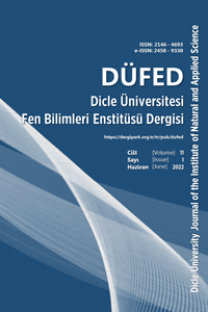KEÇİ YETİŞTİRİCİLİĞİNDE TEKE ETKİSİNDEN YARARLANMA
Küçükbaş hayvanlar mevsime bağlı poliöstrik hayvanlar olup sadece belirli dönemlerde çiftleşme eğilimindedirler. Koyun ve keçilerde özellikle doğum dönemlerinde işletme işgücü oldukça fazladır ve bu süre yaklaşık çiftleşme mevsimi süresi kadardır. İşte bu sürenin kısaltılarak işletme işgücünü daha dengeli olmasını sağlayabilmenin farklı yöntemleri vardır. Bu yöntemlerden biri de teke etkisinden yararlanmaktır. Bu yöntem ile keçilerin kızgınlık ve yumurtlama işlemlerinin arzu edilen zaman içerisinde oluşumuna imkân sağlamaktır. Bu derleme ile doğal yöntemlerle herhangi bir ücret ödemeksizin teke etkisinden yararlanılarak keçilerin kızgınlık ve yumurtlamalarının toplulaştırılması ile diğer kullanılan yöntemler hakkında bilgilendirmek amaçlanmıştır
UTILIZATION FROM BUCK EFFECT IN GOAT BREEDING
Small ruminants are seasonal poly estrous animals and tend to mate only at certain times. In sheep and goats, the workforce is especially high during the period of pregnancy and this period is about the duration of the mating season. There are different ways of shortening this workforce and making the workforce more balanced. One of these methods is to utilize the effect of the buck. With this method goats’ estrous and to allow the ovulation process to occur within the desired time.With this review, it is aimed to inform about the gathering of the estrous and ovulation of the goats and other used methods by taking advantage of the buck effect without paying anything with natural methods
Keywords:
Teke etkisi, Kızgınlık döngüsü Çiftleşme,
___
- JA. Abecia, Forcada F. Zuniga O. A Note on The Effect of İndividual Housing Conditions on LH Secretion in Ewes After Exposure to A Ram. App. Anim. Behav. Sci. 75 : 347- 352. (2002).
- PM. Bartlewski, Beard AP. Cook SJ. Rawlings NC. Ovarian Activity During Sexual Maturation and Following İntroduction of The Ram to Ewe Lambs. Small Ruminant Research, 43 : 37-44. (2002).
- J.A. Delgadillo, Gelez H., Ungerfeld R., Hawken P.A.R. and Mar-tin G.B. , The ‘male effect’ in sheep and goats-revisiting the dogmas. Behav. Brain. Res. 200(2), 304- 314. (2009).
- J.A. Delgadillo, Flores J.A., Véliz F.G., Duarte G., Vielma J. and Hernandez H. Fernandez I.G. Importance of the sig- nals provided by the buck for the success of the male effect in goats. Reprod. Nutr. Dev. 46, 391-400. (2006).
- J.A. Flores Véliz F.G., Pérez-Villanueva J.A., Martínez de la Escalera G., Chemineau P., Poindron P., Malpaux B. and Delgadillo J.A. Male reproductive condition is the lim- iting factor of efficiency in the male effect during seasonal anestrous in females goats. Biol. Reprod. 62, 1409-1414. (2000).
- E.S.E. Hafez Reproduction in Farm Animals. Sixth Edition. Lea and Febiger, 600 Washington Square in Philedephia. PA 19106-4198, USA. (1993).
- P.A.R. Hawken Evans ACO. Beard AP. Short Term, Repeated Exposure to Rams During The Transition into The Breeding Season İmproves The Synchrony of Mating in The Breeding Season. Anim. Reprod. Sci. 106(3-4): 333-344. (2008).
- M. Kaymakçı İleri Koyun Yetiştiriciliği. İkinci Baskı. ISBN 9944-5334-0-8 Bornova İzmir. (2006).
- GM. Martin Oldham CM. Cogni´e Y. Pearce DT. The Physiological Responses of Anovulatory Ewes to The İntroduction of Rams—A Review. Livest. Prod. Sci. 15, 219–247. (1986).
- H. Okamura and Mori Y. Characterization of the primer pheromone molecules responsible for the ‘male effect’ in ru-minant species. Chem. Sens. 30(1), 140-141. (2005).
- G. Özdemir, Daş, A., Nursoy, H., İldiz, S., Evaluation of Applications of in Bingol Province Mating Season in Small Animal Breeding. Van Vet J, 2015, 26 (1) 13-16. (2014).
- N. Özyurtlu, Bademkıran, S., Estrus Synchronization and Induction of Estrus Methods in Sheep. Dicle Üniv. Vet. Fak. Derg. 2010-1(1): 17—22. (2015).
- O. Radostits, Leslie, K., Fetrow, J., Herd Health: Food Animal Production Medicine. Saunders, Philadelphia. (1994).
- H.J.D. Rosa, Bryant M.J., Seasonality of reproduction in sheep. Small Rumin. Res. 48:155– 171. (2003).
- R.J. Scaramuzzi , Campbell, B.K., Downing, J.A., Kendall, N.R., Khalid, M., Mu˜noz-Gutierrez, M. and Somchit, A. A review on the effects of supplementary nutrition in the ewe on the concentration of reproductive and metabolic hormones and the mechanisms. that regulate folliculogenesis and ovulation rate. J. Reprod. Nutr. Dev. 46, 339-354. (2006).
- J.P. Signoret, Sexual Pheromones in The Domestic Sheep : İmportance and Limits in The Regulation of Reproductive Physiology. J. Steroid Biochem. Mol. Biol. 39 : 639-645. (1991).
- D.C. Skinner, Cilliers, S.D., Skinner, J.D., Effect of ram introduction on the oestrous cycle of springbok ewes. Reprod. 124:509-513. (2002).
- H.D. Şireli, Tatar, A.M., Tutkun, M., Tekel, N. Use of the Ram Effect (RE) in Estrus Control and Its Importance in Sheep Breeding. Dicle Üniv Vet Fak Derg 013:1(3): 14-18. (2013).
- R. Ungerfeld, Reproductive responses of anestrous ewes to the introduction of rams. Doctoral thesis, Swedish University of Agricultural Sciences, (2003).
- R. Ungerfeld, Ramos, M., Gonzales Pensado, S., Ram effect: Adult rams induce a greater reproductive response in anestrus ewes than yearling rams. Animal Reproduction Science 103, 271-277. (2008).
- S.W. Walkden-Brown, Restall, B.J. and Henniawati, The male effect in the Australian cashmere goat. 2. Role of olfac- tory cues from the male. Anim. Reprod. Sci. 32, 55-67. (1993).
- M. Yardımcı , Şahin, E.H., Koyunlarda koç etkisinden yararlanarak kızgınlık aktivitesinin düzenlenmesi. Lalahan Hay. Araşt. Ens. Derg. 43(2): 35-40. . (2003).
- ISSN: 2146-4693
- Yayın Aralığı: Yılda 2 Sayı
- Başlangıç: 2012
- Yayıncı: Dicle Üniversitesi
Sayıdaki Diğer Makaleler
KEÇİ YETİŞTİRİCİLİĞİNDE TEKE ETKİSİNDEN YARARLANMA
DİYARBAKIR İLİNDE İPEKBÖCEĞİ YETİŞTİRİCİLİĞİNİN GENEL DURUMU
İlkay BARITCI, Cemal ADIGÜZEL, Murat KANAT
Sığırlarda besi sonu ağırlığına besi başı ağırlığının etkisinin kovaryans analizi ile incelenmesi
Dudu YAZGAN, Zeki DOĞAN, Kemal YAZGAN
Diyarbakır İli antepfıstığı Pistacia vera L. bahçelerindeki zararlı böcek faunasının belirlenmesi
Durum Buğdayda Verim Öğelerinin Sıcaklık Stresine Tepkisi
Sertaç TEKDAL, Mehmet YILDIRIM, Hasan KILIÇ
Havası Alınmış Yalıtım Malzemelerinin Sıcak Su Dağıtım Borularında İncelenmesi
